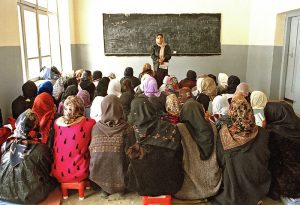
Education is the key to development. Prioritizing girls’ education improves their livelihoods while also increasing the overall economic and social well-being of entire countries. Many countries have made progress in boosting the number of girls attending school and are reaping both the social and economic benefits. Other countries, however, still have a long way to go.
In this blog we’ll explore the far-reaching benefits of girls’ education and which countries are making strides towards gender equality.
The Global Impact of Girls’ Education
Girls who stay in school longer have smaller, more economically stable families, experience better health outcomes for their children, and are more likely to participate in the workforce.
Later Marriages and Smaller Families
Across the globe, 650 million girls under the age of 18 are forced into child marriages and start childbearing at a young age. When girls can focus on secondary education and beyond, they tend to marry later and delay childbearing, often having fewer children over the course of their lifetimes.
Research shows that smaller families are easier to support economically, with more financial investment per child, leading to better outcomes for individual children and their families altogether. Women who have children when they’re fully developed also experience fewer complications during childbirth and are less likely to face forms of violence like intimate partner abuse.
Improved Health for Women and Children
When women stay in school, the health of their children improves. In fact, a child born to a mother who can read is 50 percent more likely to survive past the age of 5 than a child born to an illiterate woman. This is because more highly educated women are more likely to learn about infant nutrition, child development, and medical services through multiple sources.

Better educated women also gain more agency and are more often involved in decision-making about medical services for their children. Moreover, girls who stay in school longer tend to be educated about risks like HIV/AIDS transmission in childbirth and the dangers of practices like female genital mutilation that can harm the health of both women and their babies.
Empowering Women in the Workforce
Girls who attend school develop life skills like critical thinking and negotiation that help them secure a well-paying job in the labor market. According to the Malala Fund, women who complete their secondary education are likely to “earn twice as much as women with no education.” Women with a higher income can better support their family members and children. This then leads to making better family healthcare decisions, reducing child malnutrition, and breaking the “vicious cycle” of poverty for her kids and future generations.
Women are also more likely to give back to their communities when they can financially support themselves and their family. According to CAMFED, successful female entrepreneurs not only provided goods to their rural communities but also used their profits to help more kids attend school. When countries invest in girls’ education and women can give back to their communities, countries receive a return in investment, spurring economic growth and raising their annual GDP per capita.
Comparing Global Progress in Girls’ Education
Globally, gender parity in education has improved over the years. Currently, 90% of all girls attend primary and secondary schools worldwide in comparison to 92% of all boys. While this is major progress, certain countries have noted greater strides in women’s rights, education, and workforce opportunities than others.
Here we will compare three countries with different levels of gender parity and examine the impacts of education access on social and economic development.
Education in Afghanistan: Barriers and Setbacks
Since the Taliban’s takeover in 2021, girls’ education rights in Afghanistan have quickly diminished. Afghanistan has banned higher education for girls ages 12 and over and is the only country in the world to do so. This has resulted in 80% of the school-aged girls, or 2.5 million girls, not having access to education. The number of students attending universities has also dropped by over 50%.

A packed classroom in the Zarghuna Girls School in Kabul, Afghanistan in 2002. Currently, higher education for girls over 12 is banned in the country.
Banning female education has put a strain on Afghanistan’s economic and social development. Increased rates of child marriage and teenage pregnancies in Afghanistan have led to higher rates of infant and maternal health dangers like low birth weight, prematurity, and increased risk of hemorrhage. Afghani women can also only be treated by female healthcare providers, but the number of women in healthcare has decreased with the Taliban’s rule. This puts women’s health in greater danger and exacerbates the country’s already high infant mortality rate.
On the economic front, only 7% of Afghani women now have jobs outside of the household, resulting in a major decline in workforce expansion, domestic production, and an overall economic crisis for the country.
Education in Uganda: Expanding Access and Opportunity
From 1997 to 2023, Uganda made significant strides in gender parity in education with enrollment at 99.3%, almost equal for girls and boys. In 2007, Uganda implemented the USE program which abolished tuition fees and increased accessibility to school facilities for girls and other marginalized groups. As a result, Uganda experienced a significant increase in schooling years for girls, leading to positive educational, marriage, and economic outcomes. Research showed that Ugandan women who enrolled in higher education after using the USE program moved in with their spouses and began childbearing later in life. They were also given more resources for skills training and had more autonomy in household decision-making. All these factors have increased women’s empowerment in Uganda leading to greater participation in the labor market and economic growth.
However, Uganda still holds many barriers in the workforce that interfere with long-term economic growth. These include job segregation in pay and representation, under-employment, reductions in high-paying jobs, and a lack of services like childcare that help women work full-time. The country has implemented legislation including the National Gender Policy which states that government officials are committed to the promotion of gender inclusion for the betterment of their economy. But more vocational training and STEM education is needed in Uganda to get girls more involved in the current labor market demands.
Education in Norway: A Model for Gender Equality in Education
Since the late 19th century, many women’s rights movements have taken place in Nordic countries like Norway, leading to an increase of girls in school and ultimately a jump-start on social and economic development. Today, 98% of girls in Norway attend secondary school and girls outperform boys in international tests on reading and math. In contrast to Afghanistan, Uganda, and even many other developing countries, girls in Norway are more likely to go to university than boys. There is a strong connection in Norway between pursuing higher education and maternal health benefits — women who finished graduate school lowered their maternal health risk outcome by 36%.
Many women in Norway work jobs outside of the household due to the successful implementation of “family-friendly” childcare support like after-school programs and generous parental leave policies. However, despite these successes, women in Norway still struggle to obtain higher managerial roles, often picking female-dominated fields including teaching and nursing, and face underrepresentation in STEM fields.
At large, Norway’s efforts to promote gender equal education and job support has made it one of the most inclusive economies in the world. These impacts have resulted in bolstering the country’s economic growth and maintaining a higher-than-average GDP per capita.
Educating Girls Builds a Better Future for All
Girls’ education is a human right and holds the key to both societal and economic progress. Understanding the universal benefits from increased girls’ education is critical to ensuring that all women across the globe receive equal access to education, employment, and healthcare. Cross-country benefits can help us identify where progress has been made, where gaps remain, and what initiatives might bring more gender equity to society in the years ahead.
Images: Graduation caps (Girls Graduate by unfurl is licensed under CC BY-NC-ND 2.0.); Girls in classroom in South Sudan (Supporting girls’ education by Oxfam East Africa is licensed under CC BY 2.0.); Girls school in Afghanistan, 2002 (Afghanistan: UNICEF Girls’ Education by United Nations Photo is licensed under CC BY-NC-ND 2.0.)


